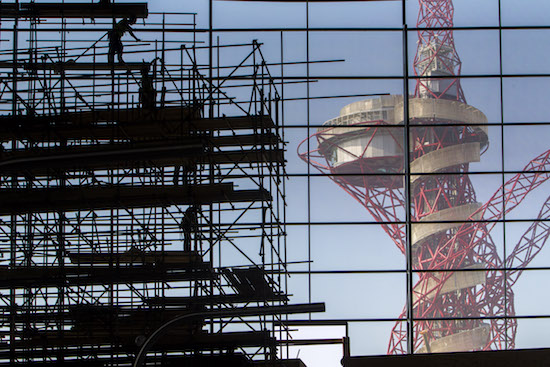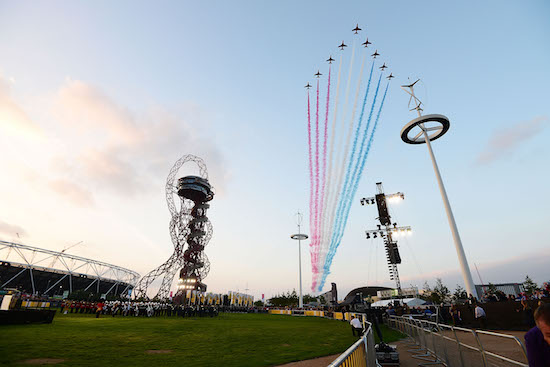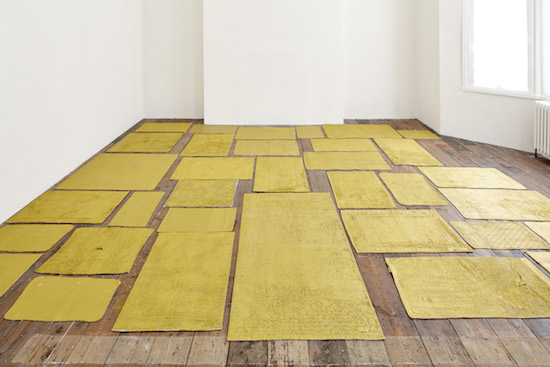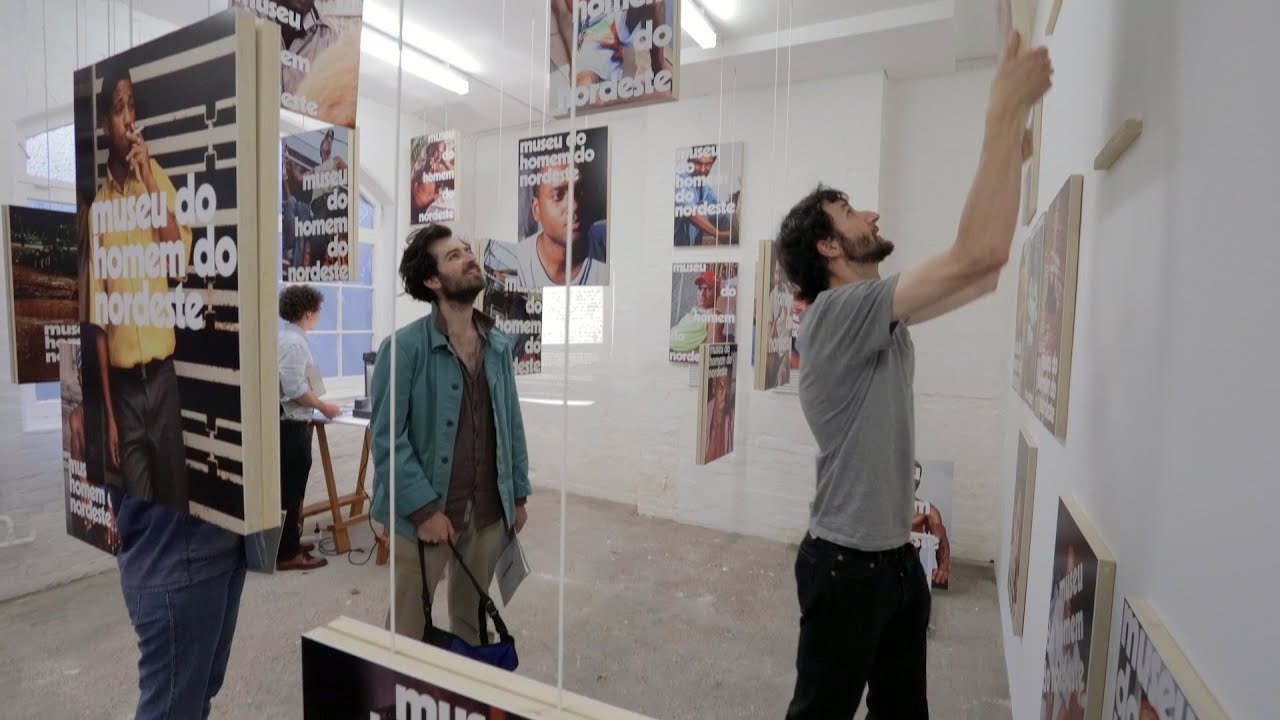Installation view: Under the Same Sun: Art from Latin America Today, South London Gallery. Courtesy: Solomon R. Guggenheim Foundation & South London Gallery. Photo: Andy Stagg
As the embers of the Rio Olympics closing ceremony fireworks slowly simmer out on the concrete slabs where favelas once stood, the London games four years ago seem a distant childhood memory. But it’s still an ongoing concern while imagined notions of regeneration still hang like shackles around LOCOG and the assorted developers they got into bed with. In Brazil 2016 only vague promises of urban improvement and re-framing the city to the watching world were suggested, but in London we were led to believe it was the real point of the bid for the games – the ‘legacy’.
Regeneration is a word they couldn’t shake off after rooting it so deeply into their initial proposal, though it’s proved semantically pliable enough to still be used while serving a different agenda to the fictionalised sales-pitch of the LOCOG bid. The reality of that legacy, we now know, is less wonderful than the imagined promise. In short it amounted to selling the Olympic Village apartments to the Qatari royal family for £275m less than their build cost, pretty much giving away a £700m stadium to a Premier League football team and creating a park which seems to only exist to pull people through the lobster pot Westfield shopping centre. The icon of it all is the ArcellorMittal Orbit, cheap advertising for a steel magnate masquerading as a mangled roller-coaster which has now had the world’s most expensive helter-skelter wrapped around it in a desperate attempt to cover up the reality of Boris Johnson’s pathetic legacy.
A mediated fiction to cover the cracks of reality, and just as the Olympics claims to care about culture as much as sport (and advertising opps, land-grabs, drug-taking and greed) so the site left behind after 2012 was promised a creative legacy also. Olympicopolis it was to be called, though current mayor Sadiq Khan has ditched that name in favour of East London’s Heritage and Cultural Quarter – surely to be replaced with a snappy acronym as soon as a suitable sponsor arises. It was hoped to give the area the same cultural kudos as its distant West London cousin, Albertopolis, with the developers hoping for a land value and rental hike akin to the W postcodes.
But instead of working from the ground up with the plethora of arts organisations and rooted communities in the borough, the plan is to (as is the Olympics way) airdrop in massive pre-fabricated cultural brands to deliver a sure-fire success alongside recognisable chain eateries, shops and other consumer experiences including faux-pop-ups with plug-in hipsterism (for plug-in hipsters) to present a fictional façade of rootedness and reality. Initial design concepts for the new homes of these massive pre-fab organisations – including the V&A, UCL and Smithsonian – were recently released to an audible sigh. Vacuum-packed culture in red-brick (like the old West London ones, natch) modernist boxes, compressed under the weight of penthouses, capital and greed.
The grand dame Guggenheim was originally invited to this game of cultural soggy-biscuit; the elite institutions collectively spunking their collections over Stratford, the bukkake-boy from the streets desperate for the cash donation which follows the first kind. But they declined. They didn’t want to be at this party. The institution that represents global cultural colonialism like no other said “no” and, instead, loaded their contemporary collections and criticality onto the first Overground train, headed under the river to Camberwell and into the South London Gallery. Just when London was upping the cultural regeneration game to a level only usually witnessed in the oil-rich Arab states the Guggenheim turned its back and acknowledged a more purposeful sense of regeneration instead of the Olympic-iqued, semantically-mutated version which has become a synonym for money-hoovering.
This is a powerful gesture, perhaps in part based on their ongoing issues in Helsinki where the public have overwhelmingly risen up to say “no to the Guggenheim”, but also because they see that the South London Gallery is a sincere, rooted organisation which has, for many decades, not only put on groundbreaking and intelligent shows for those who come from all over London but, more importantly, offers an ingrained relationship of permanence, development and community to the local community. This is the reality of how art can aid regeneration – not just of landvalue and capital, but of people, thoughts, imagination and long-lasting change.

The opening gambit between the two institutions is group show Under The Same Sun: Art from Latin America Today which runs until 11th September, and it was telling that at the private view there were as many local families, playfully enjoying the evening, as there were the expected art crowd types, free-lager swiggers, poseurs, and fashion hangers.
For a shared experiment, it couldn’t be better located – to show this in the grand streets of Mayfair or Kensington would have drained it of power. But to take artists from a part of the world largely kept outside of the white gallery system and instead positioning them in a part of London which is similarly geographically close but remote and apart from the systems and structures controlling it, and people within it, is a strong statement. It is against the grain, against the glossy-brochure fiction of Olympicopolis and all it represents, against cultural apartheid and gated communities as a tool of regeneration. Richard Armstrong, director of the Guggenheim, says:
“To me it’s the counterpart to the anti-immigration, populist, reactionary analysis that is going on inside popular culture. I’ll be in trouble for this surely, but we have a lot of hatred going on inside our system. The only way we can counterbalance that is by having a lot of curiosity and respect.”
Curiosity and respect come from working with roots and community, not from being picked as flagship brand by a developer with units and dreams to shift.
The anti-immigration and populist fictions and analysis he alludes to are explored in the exhibition. It contains a wide mix of work, all with political charge and much with a participatory slant or inviting action and due to the South American nationalities of the artists, the US – and associated migration, culture, politics – is explored as they all try to push up the neoliberal US thumb they are collectively squashed under.
Alongside the exhibition in the two SLG buildings (two, as they have recently extended into the raw spaces of a semi-derelict Victorian fire-station as if to demonstrate their genuinely regenerative intent) an array of ‘special project’ residencies were also embarked on. Federico Herrero has worked with local residents to transform a kid’s playground with a bright floor-mural, Amalia Pica invited participants to bring a chair to Peckham Square and form a circular, communicative space which never closed, and Alfredo Jaar interrupted the never-ending capitalist fiction of Piccadilly’s advertising screens with his political work A Logo for America.
For her residency project, Cuban artist Tania Bruguera spent July to August in London further developing her ongoing research project Immigrant Movement International (IMI) through a series of think-tank sessions, co-hosted by sociologist Saskia Sassen. IMI is a mission with a manifesto to widen acknowledgement and consideration of refugees, envisioning a different legal reality for human migration. It works to take the idea of “immigrant” out of the fictive imagination and address the realities of it – recognising the benefits of international connectivity, part of an “engine of change”, and to value the depth of intellectual capacity that migrants carry with them on their travels instead of solely being considered as a flattened symbol of the product of their labour.
The culmination of her London research period saw Bruguera and Sassen in conversation at the London School of Economics. The hosting organisation was Theatrum Mundi, a wide network of individuals from performing and visual arts, the built environment, academia and sociology founded by Richard Sennett to oscillate between the imagined and real, providing critical research and artistic suggestion alongside physical projects on a global scale.
Their conversation focused on the immigrant, their acceptance and role in society and how their privileged position can be a force for good, change and urban strength rather than, as is the commonly mediated case, an outward force attacking, changing and affecting all that is good, safe and true about a place. A few different Bruguera projects were raised to illustrate, including Migrant People Party, a political party created to enter the 2012 Mexican elections centred on taking steps towards the disappearance of borders, and Dignity has no Nationality, where she invited the Pope to “extend Vatican citizenship, as a concept and a legal right, to undocumented immigrants” through a mass-letter-writing campaign.
When they spoke of boundaries as a human construct – “What are the nation states? They are fictions we have created”, said Sassen – I imagined not only the pink dotted lines that demarcate a nation’s limits but also those that separate Stratford from not-Stratford, the borders of Olympicopolis, the hard edges of ‘regeneration’ zones, and unspoken boundaries between the strata of societies they pretend to work for and those they actually service.

This discrepancy between fiction and reality is the critical one here, after all it is arguably the fiction peddled by certain media and politicians which ‘won’ the Brexit vote over the Remain argument which never argued the reality strongly enough. Because fiction is powerful, it absorbs personally designed narratives and, as a counter to the fixed hard facts of reality, acts like a trickster. Fiction is the dream that the Olympicopolis developers peddle, CGI and adaptable, it is simply an alternative which can play to suit mass ideal fictions. Reality, however, is burrowing beneath that glossy sales pitch to understand the structures, to see who really benefits. It’s not usually those who are presented the dream.
Reality is hard work, it’s hard to frame in a simple and accessible narrative. Fiction is an easy sell, which is why it has become the stock-in-trade of a media in thrall to celebrity, simplicity and soundbites. Take another proposed London development to the west of Stratford, the Garden Bridge by serial trickster Thomas Heatherwick. It solely exists in fictive image – a photoshopped romantic English garden, never with more than seven people in, unanchored and floating in a permanent London sunset. Of course, this is a fraudulent dream as in reality it has a queue system for 2,500 with the same number on the bridge, a conga line shuffling slowly past shrubs on a private mass of concrete. The reality is that a public park is being destroyed in favour of a commercial unit, the reality is a greenwash façade covering up cheap commercial sponsorship and attempts for murky organisations to give themselves a thin veneer of generosity. But reality is a hard sell. It’s hard to explain and explore these neoliberal agendas. And when media such as the Evening Standard uncritically promote the fiction in order that their oligarch proprietor and editor can curry personal political and business friendships with the elite then it’s even harder for those bothering to unmask that fiction.
Bruguera said, “immigrants are often more equipped than the people helping them”. She was referring to the knowledge and skills of a people who had decided, for various reasons, to uproot and move. That immigrants shouldn’t be patronisingly treated as empty vessels to begin again, from the bottom up, but are a mine of richness to contribute to the societies and communities they relocate to. And I thought of the inverse, too. I thought of Stratford post 2012: a landscape of businesses, community and existing artistic culture, who didn’t need the kind of imperialist help that Olympicopolis delivers. But they needed that actual help of funding, assistance, space and time to develop their own ideas. Exactly the same as Bruguera convincingly argue the immigrant needs.
Sassen and Bruguera, in their respective fields, seek to illuminate the absurd fictions they see in the world – whether geographical, cultural, social or political – and both shed light on the realities at play as well as offer up new potential realities as models. Duplicitous media presents the fiction of immigration in order to serve the interests of a few in exactly the same way as it presents the fiction of a so-called Garden Bridge as a cover to conceal the reality that a few connected individuals increase their wealth and power. Reality threatens their position, their power.
The Guggenheim took the brave decision to opt out of playing this game of fictions which the elite peddle to protect their status quo. They could easily have built a new Olympicopolis outpost, taken the glory of being an agent of ‘regeneration’, extended a global hegemony, gained thousands of five star ratings on Tripadvisor to beef their brand and carried on the neoliberal myth that, purely by existing, art is a force of good. But they took the harder option and went to Camberwell to be an active agent for change, to enable artists to contribute, explore a reality and propose a new one. To break the fiction. It’s what Theatrum Mundi were created to do, it’s what the South London Gallery have been doing for decades, it’s what artists like Bruguera and sociologists like Sassen are interested in. It’s not the easy route, but it’s the one that must be taken.
Under The Same Sun: Art from Latin America Today at the South London Gallery runs until 11th September



